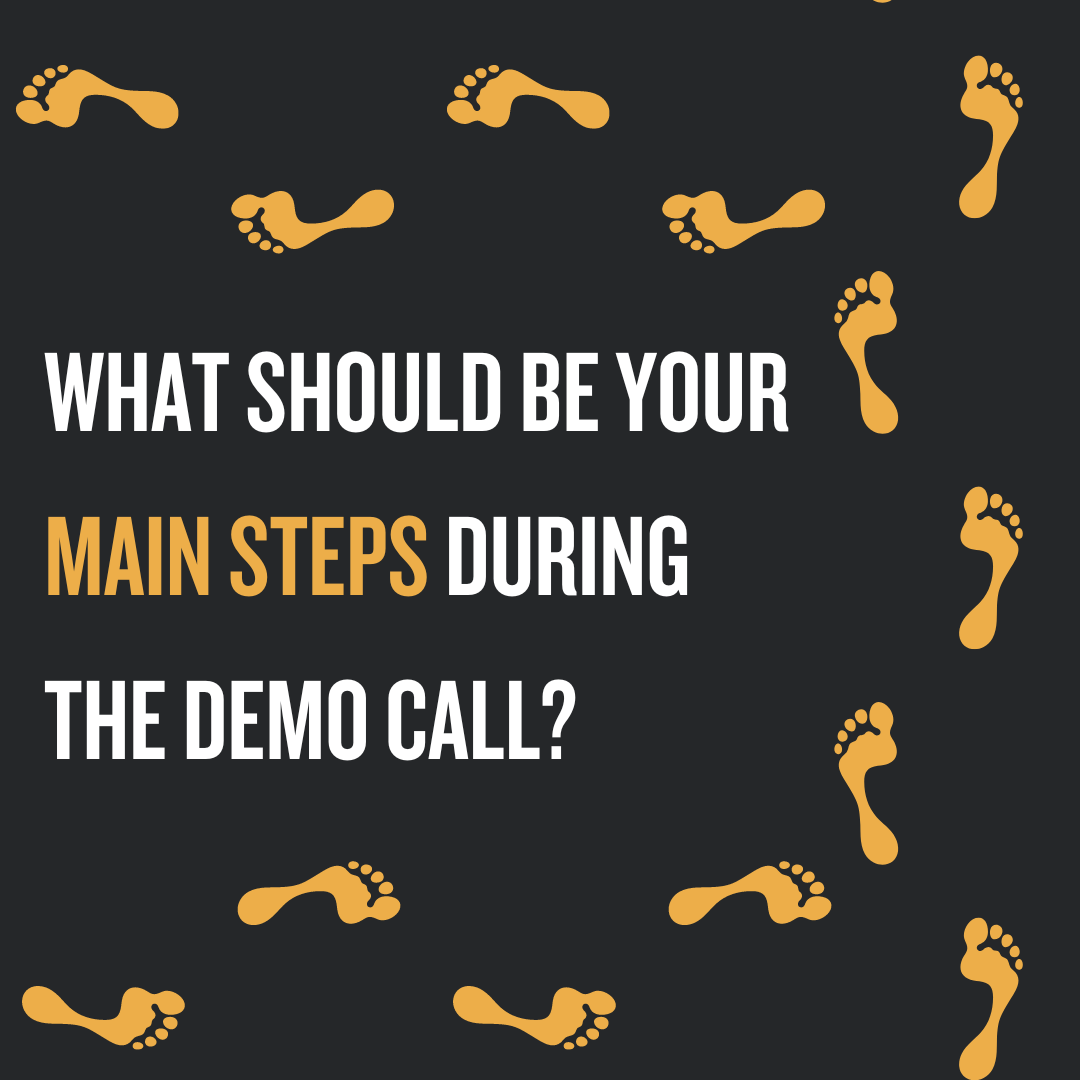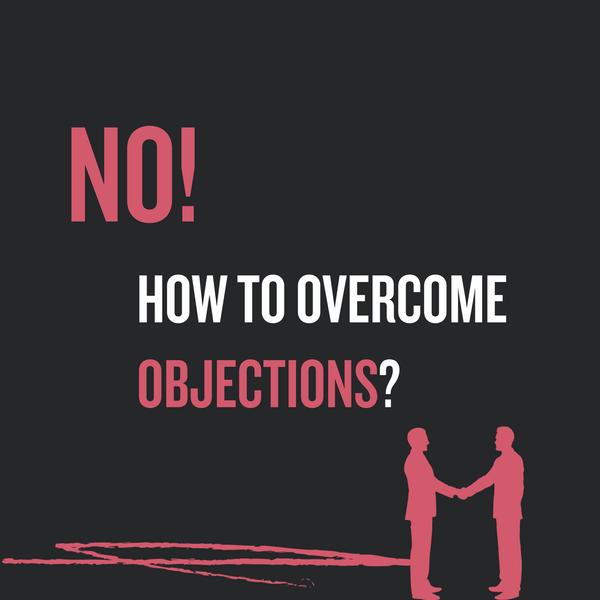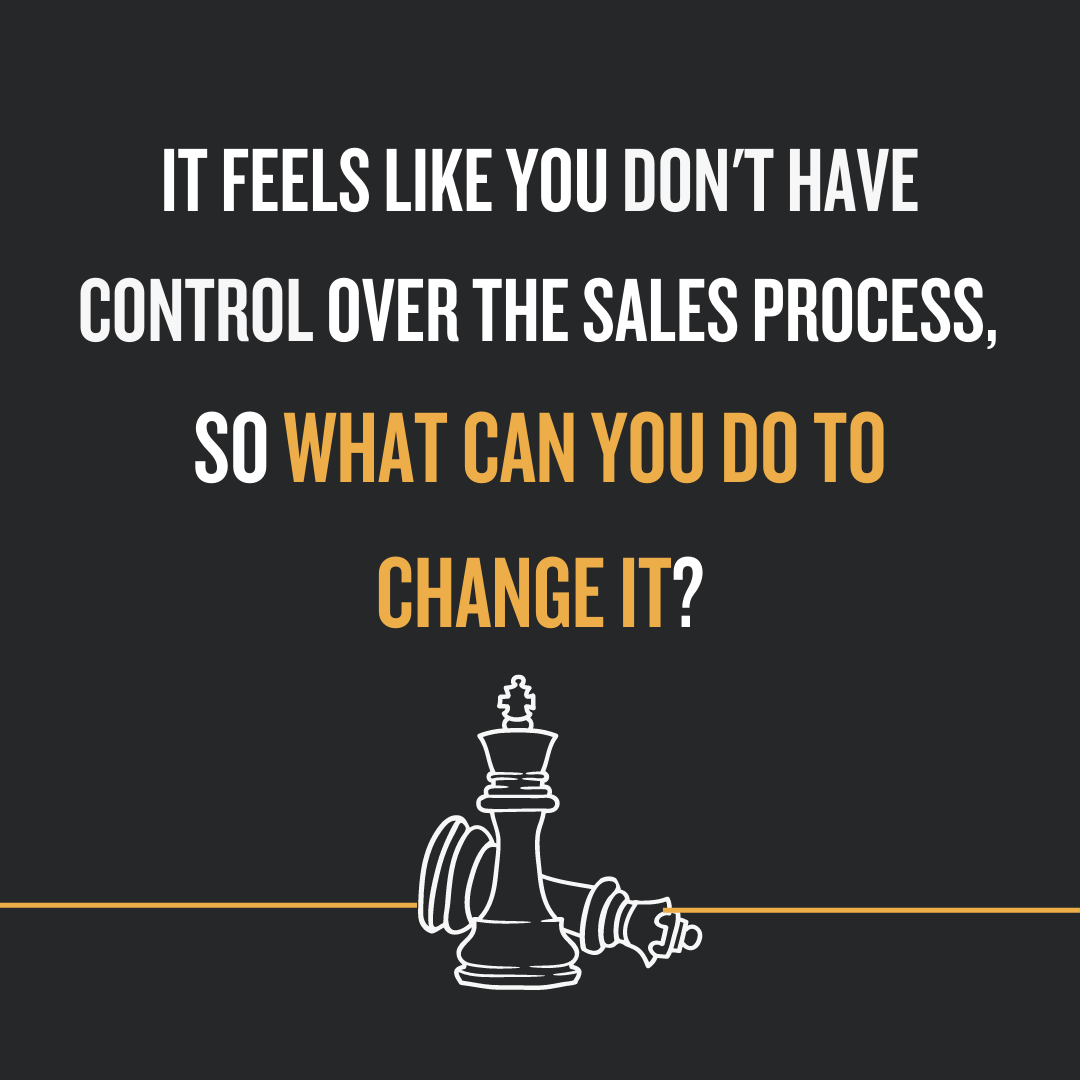Previously we’ve talked enough about planning your demo call and ongoing preparations and you can check out my articles on planning here.
But what should you be doing during the call itself? What should be your main steps during the call? In this article, I’ll cover the main steps that will help you handle your next call as smoothly as possible.
Worksheets are available to download later below.
STEP 1. “Is it ok if I record this call?”
During any sales call your goal is to build trust and one of the key factors of trust is honesty. There is nothing wrong with recording your call, not at all. After all, you’ll need those recordings. But you need to understand that prospects might not like to be recorded and it’s their right to say “no” to that.
So, my advice here is, to be honest, and just ask your prospect:
“Is it ok if I record this call?”
It takes one second and a single sentence to add a little bit more to the trust-building between you and the prospect.
Plus, in some areas it’s forbidden by the law to record a person without their agreement, so be aware of that as well. We want to take actions that will help our relationship with the prospect, not actions that will damage it.
If you often forget to let the prospect know that you are recording the call, try writing it on a post-it note and sticking it on your computer screen so you see it every time you hop on a call.

STEP 2. Take time to build Rapport
Yes, we've all heard that it's critical to establish rapport at the start of a conversation, also known as “the chit-chat part of the call.” But contrary to popular belief some sales reps hate building rapports and prefer to avoid it. Usually, those reps say things like:
“No, no; I'm not like that; I'm a challenger rep and I don't do things like that.”
What it all boils down to is that we need to change our style, whether we're a challenger seller, a regular seller, or a more relational one, in order to adapt it to the prospect's personality type and preference.
As salespeople, we have a really difficult job. And one of the tasks we must accomplish in a short time period is to really understand:
Are the prospects on the other end of the call want to discuss their children and golf game or do they just want to get down to business?
So, in the first few minutes, when I say establishing rapport is the first step, please keep in mind that I mean engaging the prospect on the call. So you can quickly determine whether it's time to dive into business right away or make a little bit of small talk.

The second thing to consider is that you don't have to discuss the weather or any other cheesy topic. My advice here is to do a lot of research on the company. Maybe you’ll notice they've established a new division or there was something newsworthy published on LinkedIn, and you can incorporate that.
And you may ask:
“What if I’m not a small-talk person and want to stick to business?”
And I say that it’s perfectly fine. However, this sales style has a trap. And that's what I see when reps ask questions that are too business-oriented in the beginning: the prospect takes it as an indication that you're ready to get down and dirty with business. What happens here is that the rep must withdraw it to return to the topic on hand.
Second, we want to have a clear agenda where we all know where we're heading and what direction we're going in.
But firstly, make sure that you're reading the other person, just to understand, hey, is it okay if we start by saying hello and being more relational? Or do they want to talk about business right now? Then act appropriately.

If you can, look up some interesting business items about their operation. If they're a smaller company, you won't find much on the news; but perhaps you go to their website and still discover some intriguing talking points.
Take your time and practice this exercise to prepare for your next call!

STEP 3. Introduce everyone
You've jumped on the call. Now what?
It's important to do introductions, just like you would do if you were meeting the prospect in person. Here is the thing, if you're ever questioning how you should navigate through a screen share or a video call, just start doing what you would actually do in real life if you were in the same room with the prospect.
Now, after you've asked the person how their day is going, you would introduce them to the people around. Here I recommend introducing yourself, and your role, and saying something like, "Hey, before we dive into a proposed roadmap for our call or agenda, I love to just go around the room and do some quick introductions. Introduce yourself, and your role, and then have your team introduce themselves and their role."
It's always nice to start introductions from your side first with your team rather than handing the reins over to your prospect. There are a few people on the prospect side who might try to avoid the awkwardness by asking if you want to go first or not, especially if everyone is calling remotely.
So, here I propose taking control of the situation and saying:
"OK, Joe, I'd love to hand it off to you for intros, and then Joe can introduce himself before passing it on to Nick".
And if he doesn't pass it on to Nick next, you might say:
"Great, thank you, Joe. Then move over to Nick., OK, fantastic."
When your introductions are done, it’s time to move to the agenda.

STEP 4. Propose an agenda
The next step is proposing an agenda. This is something that comes naturally for people who have been in business for a long time, but for people who are pretty much new to sales, it can be a little bit harder. If you are in the second category, don't worry - here is some information to help you with this step:
So, number one: Why do you propose an agenda?
People might not be aware of your time but they for sure want to know how they're spending their own. So, when you are on a call with a prospect, you want to show them that you respect them. This means proposing how you will spend the time together.

Number two: you want to make sure that the call isn't about you, but about the prospect.
So, you're coming in with a hypothesis on what their greatest need is. It’s very important to figure out what the prospect wants to achieve because this gives a shared understanding of that topic. It may take time to have a concept of your prospect's needs but it’ll be worth it.
So, lastly, when you're proposing an agenda, there are three steps that I advise to make:
- propose the agenda
- state the value
- check for acceptance.
It should take you no more than 30 seconds to complete this task. It's crucial to have a clear sense of where you're going and that the prospect is on board with it.

An agenda, for example, might sound like this:
“You know, today I'm really looking forward to diving in with a number of questions regarding your company just to get a deeper understanding of your present position, needs, and how things are going with your current solution. And if we do decide to go forward with a demo, on exactly where we can make the most effective use of your time, that will better position us. How does that sound to you?”.
You went on to speak about visiting you and asking you a slew of questions so that they know what to anticipate, then you can say:
"When I ask you these questions, it will allow us to really make the most of our time if we move to a demo," and then checking for acceptance by saying, "How does that sound?" And this is their chance to say something along the lines of: "Hey, sounds great! But...” or “Yes!" or just “That doesn't sound good.”
Now, it's important to talk about what happens if your prospect says: “I just want to know what the price is.”
A lot of reps simply turn down prospects with an answer like this:
“We'll get there later...”
And the prospect feels ignored. If they asked you about the price early on, you need to make them feel acknowledged, not ignored. So, the best way to do it is to explain why it's not the greatest idea to jump into pricing right away.
The most important thing is: that how you might handle pricing questions will define our success. Now, how can you handle this situation though?
Here I advise saying something along the line:
"We want to provide the best solution for you and to do that we have to understand your needs first. So what I wanted to propose is just asking you a handful of questions here to understand your requirements a little bit better, and walk through the right solution for you at that point, ‘ cause that'll then tell me I don't want to just give you the standard sort of off-the-shelf pricing or solution. We want to make sure it's catered to your needs, and then we walk through the pricing. How does that sound?".
Around 30 to 40% of the prospect will respond, “No problem.” But 60 to 70% of them will say, "I just want to know the cost."
They're the prospect right now. So what should you do next? Say something like this: "Okay, absolutely. Let me walk you through a few things structurally how pricing works and how it's organized. And I can offer some ballparks as well."
Then I advise you to go into it like this: let's say you have an upfront charge as well as a monthly fee. So you may say, "We have an upfront fee and a monthly fee depending on the number of users." And hopefully, the prospect will feel acknowledged and that you are providing them with something.
Here you can suggest, "Well, you know I really do need to learn more but I can certainly offer standard pricing." on the low-end it would be X; on the high-end, it would be Y.
So you're giving them something without going into a rate card and displaying that on the screen at this time. The disadvantage to what I just said is that you might anchor them by low on the low side as well as scare them off high on the high side. But if they're hammering home pricing so early, what else are you supposed to do?
It's also a little hint to you to question the situation if your prospect is really looking for the best fit. And it's totally fine to call them on it and say, “I have to ask if the price is truly the most significant thing that interests you here.” Right. It's also acceptable to inquire about this.
The answer may be yes. If “Yes,” at the very least, when determining your pipeline and deciding where you'll invest your time with clients, now not with simply everyone who is price-sensitive, right?
Then you may go to your third line of resistance. If they don't want any of the options I mentioned, simply raise the price and guide them through it.
There are three main reasons why you should try to navigate through objections.
1. It makes the prospect feel heard and not dismissed.
2. It gives the prospect what they want while still highlighting the value of your product or service.
3. It helps you pre-qualify potential buyers to see if they are serious about buying or just wasting your time.
Remember, don’t be shy about asking if the price is important to them. Say something like this:
"You know, as you can imagine, we're talking to a number of folks per week in your situation. And typically we find that there are a number of things that are really important to them aside from price. But I'd love to understand your situation. Is price the highest-ranking thing for you?".
Yes, that's a closed-ended question, but it will help you get to know where someone is thinking. They might say no, and that's okay.
Then you can ask them what else is important to them and continue the conversation from there.

STEP 5. Check for time allotment and goals
Now that we've established rapport, done intros, proposed an agenda, and arrived at a conclusion on the discussion's roadmap? So what's next?
I have two suggestions for you.
Number one, check for time allotment.
That is simply stating:
"Hey, we were booked for 45 minutes here; just wanted to double-check that you understand."
And that way, everyone's managing each other's expectations accordingly.
As I mentioned before, we’ve already covered some stuff in the previous articles, and time allotment is one of them. You can check out my article here.
Number two, we want to ask the prospect specifically what they want to achieve on the call. Sometimes, when you propose an agenda, you anticipate that the prospect will tell you exactly what they want to get out of it, but they may not.
This is another opportunity for you to figure out what the prospect wants from the conversation. We must first check how much time they have before stating, "Hey, before I ask a lot of questions, I'd like to understand what you wanted to discuss today. What do you mean by success?"
But remember here is the tricky part. If your prospect will tell you that they want to see something in a feature, you don't want to go right into that specific feature. You need to follow the roadmap that you originally put out, which usually goes through a number of questions, etc.
Here I advise you to reassure your prospect, that you will get to that feature through the course of your conversation. This way you'll stay in control of your call and keep prospects engaged.

STEP 6. Present your company
One mistake that salespeople make repeatedly is not gaining a sense of how well your prospect understands your company.
I believe we've become accustomed to having discovery calls and demonstrations all the time. We just assume that everyone knows a certain amount about our company...And often they don't.
So, don't assume that your prospect knows all the proof points about you. Imagine having a call, talking for 10 - 20 minutes, and then suddenly your prospect says this:
“Hey, I don't really know too much about you guys. Tell me more about your organization."
Even if you are a well-established company, don't hesitate to tell the prospect about your organization, at least briefly. Take any opportunity to be very clear early on to talk about a few quick proof points.
But...there is always some hidden trap and in this case, the trap lies in talking about yourself too much.
Prospects want to know about your company, sure. But they don't want to spend minutes and minutes listening about how great your company actually is. This is a two-way street, they want to know about you as much as you want to know about them.
So let's make it about them.

STEP 7. Its time for Level Set
Okay, so now we're at the point in the conversation where you've created rapport, introduced yourselves, set up an agenda, and double-checked on time limits. You've made sure you covered all of these bases.
Now it is very important to do a quick level set on if this was a past lead, an SDR call, or inbound, maybe there are some notes you have wrt the origin of the lead.
Here I advise you to say something along the line:
“Before we dive in with questions, I just want to review what Ana had passed over to me who you spoke with previously.”
And here is why you need to say this:
1) It shows that you value the prospect's time. And that you're not going to make them talk about everything again that they have already covered with Ana, the SDR, for 20 minutes just the other day.
2) This will help you understand the current state of things before you move on. To understand what Ana told them and if she covered everything.
So, you see why this whole phase of your conversation is crucial right? When you know what is talked through and what is covered, only then you can move on with your own process.

STEP 8. Preserve your enthusiasm
You can always feel when you’re not the first prospect of the day for your rep. And here is what I mean by that: you don't feel this special and you feel like you are just one of the hundreds for this rep.
And you don't want to make this impression on your prospect, we can agree on that. So, make an effort to gather your thoughts and get into the right, positive mindset before your call.
Because that’s going to assist you in expressing your passion for what it is that you're bringing to the table. So, the main point here is to stay passionate and enthusiastic.
But here is the thing, don't try to fake or overdo it, because prospects can smell fabricated emotions from a mile away. If you're a calm and reserved person - don't try to become someone else. Be enthusiastic in your own, reserved way. Or, for example, you are overly cheerful, that's great as well. Just be yourself and express emotions and enthusiasm the way you are used to.
In these kinds of situations there is only one rule: don't fake your emotions.
Still, remember, your objective is to have the prospect talk most of the time, so you want to minimize your own speaking. Here is a small piece of advice for you: you should strive for no more than 50% talking time during a discovery call; ideally 30%.
At this point, your goal is to build an engaging and trusting conversation, to show that you're human two and you're glad to build this honest connection through the course of your call.

STEP 9. Be passionate in your own way
So, here we go with the last but not least advice for you. I can always talk about building rapport, informing about your organization, and proposing an agenda, but here is the thing: your call and efforts will have less effect if you’re not passionate.
People buy from people that they like and trust. You need to be passionate about your product, or passionate about the perspective of helping your prospect. This emotion and this absolute enthusiasm charm people better than 10 minutes of case studies.
Ok, maybe I’m exaggerating but you’ve got the point.
So the message here is to be passionate about what you're selling. For some sales reps, it’s easier because being openly passionate about something is natural for extroverts. But if you’re an introvert it doesn’t mean that you can't charm or engage your prospect.
Introverts are charming in their own, quiet way. Introverts have the ability to listen, understand and charm prospects with their professional observations. So, the main point here is to be yourself and let your personality shine.
Remember, demonstrating your confidence in your ability to solve prospects’ needs once you know what they are is really important. It doesn’t matter how sociable you are. You can do this with your tone and cadence, in your own authentic way and this will charm your prospect better than anything else.

Navigating your demo call can be frustrating, but to make your process easier you can use the worksheets created for this article.
Download worksheets
And, as promised, feel free to download these worksheets to practice new knowledge!








